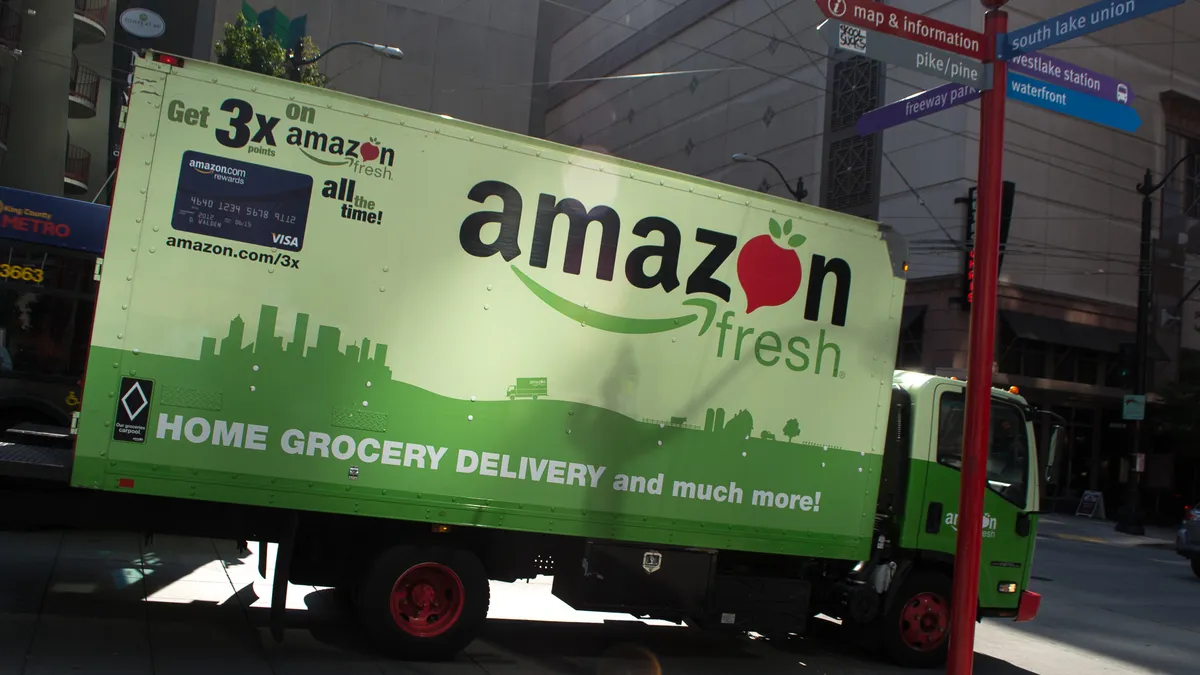Dive Brief:
- Amazon will account for an estimated 18% of online food and beverage sales, according to a press release from market research firm Packaged Facts. Walmart has the second-highest share in the market, with 9% of sales.
- Despite its overall sales dominance, Amazon struggles with selling fresh foods online, with its AmazonFresh service accounting for less than 5% of sales from online-only grocers. Even after the e-tailer’s acquisition of Whole Foods, competing online retailers have an opportunity to distinguish themselves from Amazon through their fresh assortment, according to Packaged Facts.
- The firm predicts online grocery sales gains will accelerate in the coming years, with annual growth increasing from 19.4% between 2013 and 2017 to 27.1% between 2017 and 2022. Packaged Facts predicts online grocery sales will be worth nearly $42 billion in 2022 — more than triple the market’s current value.
Dive Insight:
Amazon made a giant leap into the supermarket industry with its $13.7 billion acquisition of Whole Foods this summer. But the paltry market share its Fresh service owns compared to online-only grocers underscores a very important fact: The e-tailer struggles with perishables sales.
This, according to Packaged Facts, points to an opportunity for competing retailers. Rather than try to “out-Amazon Amazon,” as the market research firm puts it, grocers should develop a unique proposition that accentuates their fresh offerings. Ahold Delhaize’s Peapod, for instance, saw $750 million in sales last year across its 24 markets, while FreshDirect totaled $600 million. Both services have loyal customer bases and are known for their strong selection of perishables.
But it’s far from smooth sailing for these online grocers. In its third-quarter financial report, Ahold Delhaize noted Peapod is seeing single-digit sales growth compared to the 20% growth the company is seeing in e-commerce as a whole.
Also, while Amazon’s fresh offerings have lagged in recent years, it’s hard to imagine this continuing into the future. Last week, the e-tailer announced it would discontinue its Fresh service in markets across several states later this month, leading many observers to note that Amazon is likely refocusing its efforts in this area.
There are broader headwinds facing the online grocery industry, Packaged Facts noted. Chief among these is lagging consumer adoption. According to the report, 79% of consumers who shop for groceries online do so a maximum of once every two weeks. That’s a significantly lower purchase frequency than in-store, which sees an average of 1.5 trips per week.
It also appears that significant investments in online grocery are struggling to gain traction. Despite the widespread rollout of retail apps that feature online ordering, just 15% of consumers say they use these apps to place their orders. And despite the increasing focus on one- and two-hour delivery from services like Instacart, just 21% of shoppers say they rely on these speedy delivery options. Half of shoppers opt for next-day delivery, according to Packaged Facts.
The report offers suggestions for improving online sales. Retailers should incorporate more local products, as consumers often cite a lack of these options as a reason for bypassing online shopping. Packaged Facts also recommends trying to increase basket sizes among regular users, who typically earn higher-than-average incomes and are receptive to building bigger orders. Personalization tools, including recommending items based on items purchased or placed in a cart, are effective too, with 58% of shoppers saying they buy items based on these recommendations.
Interestingly, Packaged Facts also recommends playing up the fun of shopping. According to its report, 70% of online consumers say they enjoy buying groceries, compared to 58% of store-focused shoppers. This suggests an opportunity to offer a visually compelling experience with lots of content and interactive elements. Physical grocery stores don’t have to be the only place where shoppers can have an enjoyable, sensory shopping experience.
Online grocery sales will accelerate over time as services evolve and as shoppers grow more accustomed to them. Store pickup, Packaged Facts notes, will likely become the preferred fulfillment method, primarily because of the lower cost to consumers and retailers. However, the firm notes, retailers will ultimately need to offer delivery, as well, in order to retain customers.









